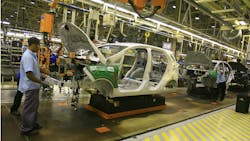COVID Continues to Take its Toll on the Just-in-Time Supply Chains
Download this article in PDF format.
The very industry that birthed the just in time (JIT) inventory management movement back in the 1950s may be rethinking the approach as it continues to grapple with raw material shortages and other pandemic-driven supply chain impacts. Based on the philosophy that goods should be received from suppliers only as they are needed, JIT helps minimize inventory (and as such, stocking costs) and improves operational efficiencies.
JIT’s origins can be traced back to Henry Ford’s production line, where he was keenly aware of the burdens of inventory. Then, in post-war Japan, Taiichi Ohno (“Father of JIT”) adapted the system at Toyota and used it to manage smaller batch sizes and a greater variety of parts used to construct assemblies.
“JIT production systems cut inventory costs because manufacturers receive materials and parts as needed for production and do not have to pay storage costs,” Investopedia points out. “Manufacturers are also not left with unwanted inventory if an order is canceled or not fulfilled.”
Where it All Began
Popularized in Japan in the 1970s, JIT at the time marked a new approach to the manufacturing process. It cut waste by supplying parts only as and when the process required them, with the “old” system becoming known (by contrast) as “just-in-case,” according to The Economist.
For example, an auto manufacturer that operates with low inventory levels—but that relies heavily on its supply chain to deliver the parts it requires to build cars on an as-needed basis—orders the parts required to assemble the vehicles after an order is received. “For JIT manufacturing to succeed,” Investopedia points out, “companies must have steady production, high-quality workmanship, glitch-free plant machinery and reliable suppliers.”
The problem is that, some of these “must-haves” have become scarce during the pandemic, where labor shortages, ongoing supply disruptions, port congestion and other interruptions have been rearing their heads on a continual basis. In “Automakers hit limits of 'just-in-time' supply chain management,” Eri Sugiura writes about how JIT processes first introduced by Toyota have been tested in the auto industry in 2021 like never before.
“[In] essence, the absolute elimination of waste in stockpiles, overproduction and unused labor hours in every manufacturing layer, has become the norm for every automaker,” Sugiura writes. “A super-efficient supply chain network spans the globe to build tens of millions of cars annually, consisting of about 30,000 parts.”
But the global pandemic surfaced vulnerabilities throughout the supply chain, including those that suggest that executives have “unwittingly traded resilience for low costs.” For example, Sugiura writes that about 7.7 million units of vehicle production will be lost in 2021 because carmakers can’t secure semiconductors, costing the industry $210 billion in revenue. “And disruptions have extended beyond chips to other parts and to assembly,” Sugiura adds, “while surges in raw materials prices have become common.”
How Fundamental and Far-Reaching?
Manufacturers in Canada are also rethinking their inventory approaches and turning to more traditional means of stocking the goods they need to make and/or sell their products. According to CTV News, shipping rates have skyrocketed amid a backed-up global supply chain caused by the COVID-19 pandemic, pushing up prices. “And the absence of just one part in a vast manufacturing network that originates in Asia can put the brakes on entire shipments,” it points out.
The current shortage and price escalations highlight the vulnerabilities of JIT and are now prompting companies to rethink their approaches. And while the concept may work well under optimal conditions, it can be vulnerable to unforeseen events like the global COVID-19 pandemic and the ensuing supply chain crisis.
“Why have we organized these systems—just-in-time or lean engineering and all that kind of stuff—when the system has proved to be unreliable to a great degree?” maritime transport expert Brian Slack asked CTV. “There’s going to be changes—the only question is how fundamental and far-reaching.”
About the Author

Bridget McCrea
Contributing Writer | Supply Chain Connect
Bridget McCrea is a freelance writer who covers business and technology for various publications.






